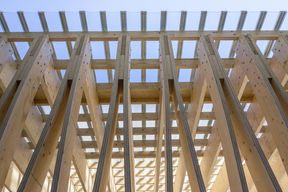Building European cities with wood would sequester half of cement industry’s current carbon emissions

Buildings around us create a whopping one-third of global greenhouse gas emissions – that’s about ten times more than air traffic worldwide. In Europe alone about 190 million square metres of housing space are built each year, mainly in the cities, and the amount is growing quickly at the rate of nearly one percent a year.
A recent study by researchers at Aalto University and the Finnish Environment Institute shows that shifting to wood as a building construction material would significantly reduce the environmental impact of building construction. The results show that if 80 percent of new residential buildings in Europe were made of wood, and wood were used in the structures, cladding, surfaces, and furnishings of houses, all together the buildings would store 55 million tons of carbon dioxide a year. That’s equivalent to about 47 percent of the annual emissions of Europe's cement industry.
‘This is the first time that the carbon storage potential of wooden building construction has been evaluated on the European level, in different scenarios,’ explains Ali Amiri, who is completing his doctorate at Aalto University. ‘We hope that our model could be used as roadmap to increase wooden construction in Europe.’
The study is based on an extensive analysis of the literature. Drawing on 50 case studies, the researchers divided buildings into three groups according to how much wood they use – and, as a consequence, how much carbon dioxide they store.
The group with the least amount of wood stored 100 kg of carbon dioxide per square metre, the middle group stored 200 kg, and the group with the greatest amount of wood stored 300 kg per square metre (CO2 kg m2). The potential carbon storage capacity was not generally related to building or wood type, or even its size; rather, capacity is based on the number and volume of wood used as building components, from beams and columns to walls and finishings.
The researchers also looked at how Europe could achieve the tremendous cut by modelling a path for reaching the level of 55 million tons per year by 2040. If say, in 2020, 10 percent of new residential buildings were made of wood each storing 100 CO2 kg m2, the share of wood-built buildings would need to grow steadily to 80 percent by 2040. At the same time the scenario demands a shift to wooden buildings that store even more carbon dioxide, with more buildings falling into the 200 CO2 kg m2-storage group, and eventually the 300 CO2 kg m2-storage group.
Energy efficiency is the most frequently used instrument for measuring the environmental impact of buildings. However, energy efficiency requires more insulation, efficient recovery of heat, and better windows. In fact, about half of the carbon footprint of zero-energy houses occurs before anyone has even lived in them.
When the energy used in housing comes increasingly from renewable sources, the significance of the construction phase of the building’s total environmental impact grows even more.
‘Certificates for green buildings used around the world, such as LEED and BREEAM, could better take the climate benefits of wood construction into account. So far, they are strongly focused on how energy is consumed during use,’ Amiri says.
In terms of wood products, a wooden building provides longer-term storage for carbon than pulp or paper. According to the study findings, a wooden building of 100 m2 has the potential to store 10 to 30 tons of carbon dioxide. The upper range corresponds to an average motorist's carbon dioxide emissions over ten years.
‘Wood construction is sustainable only if the wood comes from forests that are grown in a sustainable manner. Shifting from short-lived products, like paper, to products with a long life-cycle, like wooden construction materials, would help minimise the impact on European forests and the crucial carbon sinks they hold,’ says postdoctoral researcher Juudit Ottelin.
Creating zero-energy houses, non-toxic glitter and fossil-free glue with wood
Building wisely with wood is an efficient way to combat climate change. It’s possible to build almost anything with wood if we develop our expertise and adjust our attitudes, an expert says.

- Published:
- Updated:
Read more news

Viktar Asadchy receives Young Scientist Award
The Finnish Foundation for Technology Promotion awarded Assistant Professor Viktar Asadchy with the Young Scientist 2024 Award.
Preserving intangible cultural heritage through immersive XR experiences
Aalto University’s Department of Art and Media is coordinating a European wide project on preserving intangible cultural heritage and using it to address societal challenges with the help of immersive XR environments.Aalto computer scientists in CHI 2024
Ten papers from Aalto CS were accepted to the CHI 2024 conference